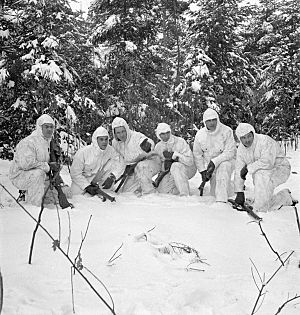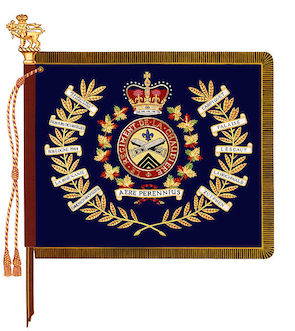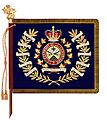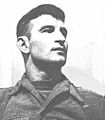Régiment de la Chaudière facts for kids
Quick facts for kids Le Régiment de la Chaudière |
|
|---|---|

Regimental badge
|
|
| Active | 1869–present |
| Country | Canada |
| Branch | Canadian Army |
| Type | Line Infantry |
| Role | Light Infantry |
| Garrison/HQ | Lévis, Quebec |
| Motto(s) | Ære perennius (Latin for 'More lasting than bronze') |
| March | "Sambre et Meuse" and "The Longest Day" |
| Engagements |
|
| Battle honours | See #Battle honours |
| Commanders | |
| Colonel-in-Chief | Vacant |
The Régiment de la Chaudière is a special kind of army unit in Canada. It's a Primary Reserve infantry regiment of the Canadian Army. This means its soldiers are often part-time, but they are trained and ready to serve when needed. The regiment is based in Lévis, Quebec.
Contents
What is the Regimental Badge?
The regiment's special badge shows two crossed machine guns. Above them, a beaver holds a fleur-de-lys, which is a symbol of France. Below, a scroll says "Aere perennius". This Latin phrase means 'More lasting than bronze'. There's also a small maple leaf on each side, representing Canada.
How Did the Regiment Start?
Le Régiment de la Chaudière has a long and interesting history. It carries on the traditions of three older units from the War of 1812. These units were the 1st Battalion, Select Embodied Militia, the Dorchester Provincial Light Dragoons, and the 1st Lotbinière Division. Because of this, the regiment has special honours for their service in the War of 1812, especially for the Battle of the Chateauguay.
The regiment officially began in Saint-Anselme, Quebec, on April 9, 1869. It was first called The Provisional Battalion of "Dorchester". Over the years, its name changed several times as it joined with other units. For example, it joined with the 23rd "Beauce" Battalion of Infantry in 1899. Later, in 1954, it joined with Le Régiment de Lévis. These changes helped create the regiment we know today.
| Lineage chart | |||||||||||||||||||||||||||||||||||||||||||||||||||||||||||||||||||||||||||||||||||||||||||||||||||||||||||||||||||||||||||||||||||||||||||||||||||||||||||||||||||||||||||||||||||||||||||||||||||||||||||||||||||||||||||||||||||||||||||||||||||||||||||||||||||||||||||||||||||||||||||||||||||||||||||||||||||||||||||||||||||||||||||||||||||||||||||||||||||||||||||||||||||||||||||||||||||||||||||||||||||||||||||||||||||||||||||||||||||||||||||||||||||||||||||||||||||||||||||||||||||||||||||||||||||||||||||||||||||||||||||||||||||||||||||||||||||||||||||||||||||||||||||||||||||||||||||||||||||||||||||||||||||||||||||||||||||||||||||||||||||||||||||||||||||||||||||||||||||||||||||||||||||||||||||||||||||||||||||||||||||||||||||||||||||||||||||||||||||||||||||||||||||||||||||||||||||||||||||||||||||||||||||||||||||||||||||||||||||||||||||||||||||||||||||||||||||||||||||||||||||||||||||||||||||||||||||||||||||||||||||||||||||||||||||||||||||||||||||||||||||||||||||||||||||||||||||||||||||||||
|---|---|---|---|---|---|---|---|---|---|---|---|---|---|---|---|---|---|---|---|---|---|---|---|---|---|---|---|---|---|---|---|---|---|---|---|---|---|---|---|---|---|---|---|---|---|---|---|---|---|---|---|---|---|---|---|---|---|---|---|---|---|---|---|---|---|---|---|---|---|---|---|---|---|---|---|---|---|---|---|---|---|---|---|---|---|---|---|---|---|---|---|---|---|---|---|---|---|---|---|---|---|---|---|---|---|---|---|---|---|---|---|---|---|---|---|---|---|---|---|---|---|---|---|---|---|---|---|---|---|---|---|---|---|---|---|---|---|---|---|---|---|---|---|---|---|---|---|---|---|---|---|---|---|---|---|---|---|---|---|---|---|---|---|---|---|---|---|---|---|---|---|---|---|---|---|---|---|---|---|---|---|---|---|---|---|---|---|---|---|---|---|---|---|---|---|---|---|---|---|---|---|---|---|---|---|---|---|---|---|---|---|---|---|---|---|---|---|---|---|---|---|---|---|---|---|---|---|---|---|---|---|---|---|---|---|---|---|---|---|---|---|---|---|---|---|---|---|---|---|---|---|---|---|---|---|---|---|---|---|---|---|---|---|---|---|---|---|---|---|---|---|---|---|---|---|---|---|---|---|---|---|---|---|---|---|---|---|---|---|---|---|---|---|---|---|---|---|---|---|---|---|---|---|---|---|---|---|---|---|---|---|---|---|---|---|---|---|---|---|---|---|---|---|---|---|---|---|---|---|---|---|---|---|---|---|---|---|---|---|---|---|---|---|---|---|---|---|---|---|---|---|---|---|---|---|---|---|---|---|---|---|---|---|---|---|---|---|---|---|---|---|---|---|---|---|---|---|---|---|---|---|---|---|---|---|---|---|---|---|---|---|---|---|---|---|---|---|---|---|---|---|---|---|---|---|---|---|---|---|---|---|---|---|---|---|---|---|---|---|---|---|---|---|---|---|---|---|---|---|---|---|---|---|---|---|---|---|---|---|---|---|---|---|---|---|---|---|---|---|---|---|---|---|---|---|---|---|---|---|---|---|---|---|---|---|---|---|---|---|---|---|---|---|---|---|---|---|---|---|---|---|---|---|---|---|---|---|---|---|---|---|---|---|---|---|---|---|---|---|---|---|---|---|---|---|---|---|---|---|---|---|---|---|---|---|---|---|---|---|---|---|---|---|---|---|---|---|---|---|---|---|---|---|---|---|---|---|---|---|---|---|---|---|---|---|---|---|---|---|---|---|---|---|---|---|---|---|---|---|---|---|---|---|---|---|---|---|---|---|---|---|---|---|---|---|---|---|---|---|---|---|---|---|---|---|---|---|---|---|---|---|---|---|---|---|---|---|---|---|---|---|---|---|---|---|---|---|---|---|---|---|---|---|---|---|---|---|---|---|---|---|---|---|---|---|---|---|---|---|---|---|---|---|---|---|---|---|---|---|---|---|---|---|---|---|---|---|---|---|---|---|---|---|---|---|---|---|---|---|---|---|---|---|---|---|---|---|---|---|---|---|---|---|---|---|---|---|---|---|---|---|---|---|---|---|---|---|---|---|---|---|---|---|---|---|---|---|---|---|---|---|---|---|---|---|---|---|---|---|---|---|---|---|---|---|---|---|---|---|---|---|---|---|---|---|---|---|---|---|---|---|---|---|---|---|---|---|---|---|---|---|---|---|---|---|---|---|---|---|---|---|---|---|---|---|---|---|---|---|---|---|---|---|---|---|---|---|---|---|---|---|---|---|---|---|---|---|---|---|---|---|---|---|---|---|---|---|---|---|---|---|---|---|---|---|---|---|---|---|---|---|---|---|---|---|---|---|---|---|---|---|---|---|---|---|---|---|---|---|---|---|---|---|---|---|---|---|---|---|---|---|---|---|---|---|---|---|---|---|---|---|---|---|---|---|---|---|---|---|---|---|---|---|---|---|---|---|---|---|---|---|---|---|---|---|---|---|---|---|---|---|---|---|---|---|---|---|---|---|---|---|---|---|---|---|---|---|---|---|---|---|---|---|---|---|---|---|---|---|---|---|---|---|---|---|---|---|---|---|---|---|---|---|---|---|---|---|---|---|---|---|---|---|---|---|---|---|---|---|---|---|---|---|---|---|---|---|---|---|---|---|---|---|---|---|---|---|---|---|---|---|---|---|---|---|---|---|---|---|---|---|---|---|---|---|---|---|---|---|---|---|---|---|---|---|---|---|---|---|---|---|---|---|---|---|---|---|---|---|---|---|---|---|---|---|---|---|---|---|
|
|||||||||||||||||||||||||||||||||||||||||||||||||||||||||||||||||||||||||||||||||||||||||||||||||||||||||||||||||||||||||||||||||||||||||||||||||||||||||||||||||||||||||||||||||||||||||||||||||||||||||||||||||||||||||||||||||||||||||||||||||||||||||||||||||||||||||||||||||||||||||||||||||||||||||||||||||||||||||||||||||||||||||||||||||||||||||||||||||||||||||||||||||||||||||||||||||||||||||||||||||||||||||||||||||||||||||||||||||||||||||||||||||||||||||||||||||||||||||||||||||||||||||||||||||||||||||||||||||||||||||||||||||||||||||||||||||||||||||||||||||||||||||||||||||||||||||||||||||||||||||||||||||||||||||||||||||||||||||||||||||||||||||||||||||||||||||||||||||||||||||||||||||||||||||||||||||||||||||||||||||||||||||||||||||||||||||||||||||||||||||||||||||||||||||||||||||||||||||||||||||||||||||||||||||||||||||||||||||||||||||||||||||||||||||||||||||||||||||||||||||||||||||||||||||||||||||||||||||||||||||||||||||||||||||||||||||||||||||||||||||||||||||||||||||||||||||||||||||||||||
Honouring Past Units: Perpetuations
"Perpetuation" means that Le Régiment de la Chaudière keeps alive the history and honours of older military units. It's like they are carrying on the legacy of these groups.
Units from the War of 1812
- 1st Battalion, Select Embodied Militia
- Dorchester Provincial Light Dragoons
- 1st Lotbinière Division
What Has the Regiment Done?
The regiment has played important roles in major conflicts.
Serving in the Second World War
When the Second World War began in 1939, Le Régiment de la Chaudière quickly got ready for action. It was first a machine gun battalion. In 1941, the soldiers went to Great Britain. On D-Day, June 6, 1944, they landed in Normandy, France. This was a huge moment in the war. The regiment fought bravely across North West Europe until the war ended. They were one of the few French-speaking units to land on D-Day.
Helping in the War in Afghanistan
From 2002 to 2014, many soldiers from Le Régiment de la Chaudière volunteered to serve in the War in Afghanistan. More than 20% of the regiment's strength helped in different missions there.
Key Moments in History
The regiment's landing on D-Day at Bernières-sur-Mer was a big surprise for the local people. They didn't expect to see French-speaking Canadian soldiers helping to free their country!
The regiment fought in the Battle for Caen, which was a tough fight. They also took part in the Battle of the Scheldt, especially in the Breskens Pocket area. After spending the winter in the Netherlands, they were active in the Rhineland fighting in Germany in 1945. They finished the war on German soil in May.
Why the Name "Chaudière"?
People in Normandy were curious about the regiment's name. In French, "chaudière" means a water heater or boiler. The regiment was named after the Chaudière River in Quebec. This river got its name because of a waterfall that looks like boiling water.
Recognizing Bravery: Battle Honours
Battle honours are special awards given to military units for their courage and service in important battles or campaigns. The honours in bold are proudly displayed on the regiment's flag.
War of 1812 Honours
- Defence of Canada – 1812–1815 – Défense du Canada
- Châteauguay
Second World War Honours
- Normandy Landing
- Caen
- Carpiquet
- Bourguébus Ridge
- Faubourg de Vaucelles
- Falaise
- The Laison
- Chambois
- Boulogne, 1944
- Calais, 1944
- The Scheldt
- Breskens Pocket
- The Rhineland
- Waal Flats
- The Hochwald
- The Rhine
- Emmerich–Hoch Elten
- Zutphen
- North-West Europe, 1944–1945
South-West Asia Honours
- Afghanistan
The Régiment de la Chaudière Museum
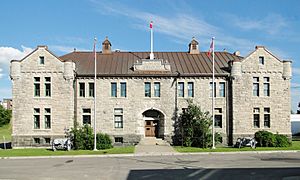 |
|
| Location | Lévis Armoury, 10 Arsenal Street, Lévis, QC G6V 4P7 Canada |
|---|---|
| Type | Regimental Museum |
The museum collects and displays items that show the military life of the regiment. It focuses especially on their service during the war in Europe from 1944–1945. You can see old uniforms, weapons, and equipment. The museum helps tell the story of Le Régiment de la Chaudière from its beginning.
Books About the Regiment
- Le Régiment de la Chaudière by Jacques & Armand Ross Castonguay (1983)
- Le Geste Du Régiment De La Chaudière by Major Armand, Major Michel Gauvin Ross and Georges Lepage (1945)
Notable People from the Regiment
- Sergeant Léo Major
- Pierre Paul-Hus
Images for kids


